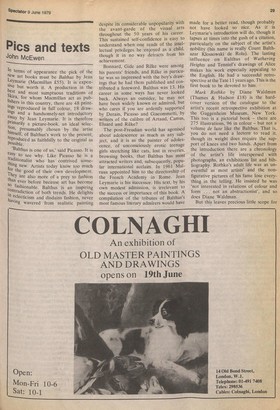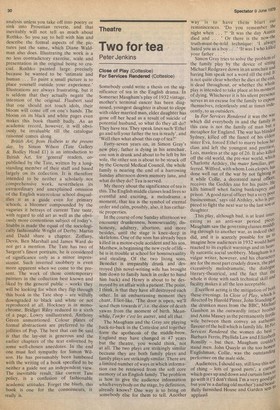Pics and texts
John McEwen
In terms of appearance the pick of the new art books must be Balthus by Jean Leymarie (Macmillan £55). It is expensive but worth it. A production in the best and most sumptuous traditions of Skira, for whom Macmillan act as publishers in this country, there are 48 paint!rigs reproduced in full colour, 18 drawings and a handsomely-set introductory essay by Jean Leymarie. It is therefore Primarily a picture-book, an ideal selection, presumably chosen by the artist himself, of Balthus's work to the present, reproduced as faithfully to the original as Possible.
'Balthus is one of us,' said Picasso. It is easy to see why. Like Picasso he is a traditionalist who has contrived something new. Artists today know too much for the good of their own development. They are also more of a prey to fashion than ever before because art has become 8° fashionable. Balthus is an inspiring Fontradiction of both trends. He delights In eclecticism and disdains fashion, never having wavered from realistic painting despite its considerable unpopularity with the avant-garde of the visual arts throughout the 50 years of his career. This sustained self-confidence is easy to understand when one reads of the intellectual privileges he enjoyed as a child, though it in no way detracts from his achievement.
Bonnard, Gide and Rilke were among his parents' friends, and Rilke in particular was so impressed with the boy's drawings that he had them published and contributed a foreword. Balthus was 13. His career in some ways has never looked back. Always an outsider, he may not have been widely known or admired, but who cares if you are ardently supported by Derain, Picasso and Giacommetti, by writers of the calibre of Artaud, Camus, Eluard and Rilke?
The post-Freudian world has agonised about adolescence as much as any subject, and it is as the painter of adolescence, of unconsciously erotic teenage girls stretching like cats, lost in reveries, browsing books, that Balthus has most attracted writers and, subsequently, popular international acclaim. In 1961 Malraux appointed him to the directorship of the French Academy in Rome. Jean Leymarie is his successor. His text, by his own modest admission, is irrelevant to the success or importance of this book. A compilation of the tributes of Balthus's most famous literary admirers would have made for a better read, though probably not have looked so nice. As it is Leymarie's introduction will do, though it lapses at times into the gush of a citation, particularly on the subject of the artist's nobility (his name is really Count Balthazar Klossowski de Rola). The lasting influence on Balthus of Wuthering Heights and Tenniel's drawings of Alice makes his work especially appealing to the English. He had a successful retrospective at the Tate 11 years ago. This is the first book to be devoted to him.
Mark Rothko by Diane Waldman (Thames & Hudson £18) is the hardcover version of the catalogue to the artist's recent retrospective exhibition at the Guggenheim Museum, New York. This too is a pictorial book — there are 275 illustrations, 96 in colour — but not a volume de luxe like the Balthus. That is, you do not need a lectern to read it, though its weight does require the support of knees and two hands. Apart from the introduction there are a chronology of the artist's life interspersed with photographs, an exhibitions list and bibliography. Rothko's adult life was as uneventful as most artists' and the nonfigurative pictures of his fame lose everything in the telling. He insisted he was 'not interested in relations of colour and form ... not an abstractionist', and so does Diane Waldman.
But this leaves precious little scope for analysis unless you take off into poetry or sink into Proustian reverie, and that inevitably will not tell us much about Rothko. So you say to hell with him and describe the formal aspects of the pictures just the same, which Diane Waldman also does. Illustrating the work is a no less contradictory exercise, scale and presentation in the original being so crucial. Rothko painted large precisely because he wanted to be 'intimate and human . . . To paint a small picture is to place yourself outside your experience.' Illustrations are always frustrating, but it is seldom that they actually negate the intention of the original. Flaubert said that one should not touch idols, their bloom will come off on one's hands. The bloom on its black and white pages even makes this book thumb badly. As an academic record, however, it will obviously be invaluable till the catalogue raisonne comes along.
British Art, from Holbein to the present day, by Simon Wilson (Tate Gallery & Bodley Head £1) is an introduction to British Art, for 'general' readers, copublished by the Tate, written by a longstanding member of their staff and based largely on its collection. It is therefore intended to be neither a scholarly nor comprehensive work, nevertheless its extraordinary and unexplained omission of the English watercolour school disqualifies it as a guide even for primary schools, a bloomer compounded by the vagaries it betrays of current Tate taste, with regard to old art as well as the obviously more contentious subject of today's. Stubbs is made the equal of the sociologically fashionable Wright of Derby. Martin and Dadd share a chapter. Zoffany, Devis, Ben Marshall and James Ward do not get a mention. The Tate has two of Sargent's finest portraits, he is considered of significance only as a minor impressionist. Such inverted snobbery is even more apparent when we come to the present. The work of those contemporary painters in the collection best known and liked by the general public — works they will be looking for when they flip through this book in the Tate shop — are wilfully downgraded to black and white or not reproduced at all. Hockney is in monochrome, Bridget Riley reduced to a sixth of a page, Lowry unillustrated, Anthony Green unmentioned. Colour plates of formal abstractions are preferred to the jollities of Pop. The best that can be said is that the lay-out is generous and the earlier chapters of the text enlivened by some well-chosen anecdotes. In the end one must feel sympathy for Simon Wilson. He has presumably been lumbered with the writing of a book specified to be neither a guide nor an independent view. The inevitable result, like current Tate policy, is a confusion of fashionable academic attitudes. Forget the blurb, this book is one for the connoisseurs, it really is.











































 Previous page
Previous page